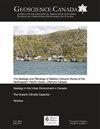加拿大不列颠哥伦比亚省基洛纳奥卡纳根断层上的原生金的微量元素组成
IF 0.8
4区 地球科学
Q3 GEOSCIENCES, MULTIDISCIPLINARY
引用次数: 0
摘要
100 年来,块金对不列颠哥伦比亚省基洛纳地区的定居、经济发展以及最近的娱乐地质学都非常重要。最著名的是在现代的 Mission Creek 和 Lambly Creek 沉积岩中,以及历史上温菲尔德矿区的中新世沉积物中发现的古块状金矿。Mission Creek 和 Winfield 矿区位于西倾、低角度、正常的 Okanagan 断层以东,该断层自始新世以来一直处于活跃状态。兰布利溪位于该断层以西。晚古生代至始新世火成岩和变质岩出现在兰姆利溪流域,但始新世片麻岩单元则出现在奥肯那根谷东侧,未被断层覆盖。这项研究检验了一个假设,即奥肯那根断层上的原生块金成分各不相同,反映了金的不同来源和历史。在一台带有能量色散光谱仪(SEM-EDS)的扫描电子显微镜上,对具有实用代表性的块状金样本进行了少量的金和银分析(23 项分析)。此外,还利用激光烧蚀电感耦合等离子体质谱法(LA-ICP-MS)对金和银分析点进行了 19 种痕量元素的分析。通过首先估算 AuRM2 外部标准中的汞浓度(约 3.69 ppm),对 "未知 "金粒中的汞进行了半定量测定。晶核中金:银:铜的比例表明,所有的金都来自中温/恒温或可能是金斑岩的基岩矿床,但原生特征可能已被变质或风化所掩盖。与兰姆利溪金矿相比,温菲尔德和使命溪金矿的金粒往往含有较高的亲硒元素铁、镍、钯和铂,以及亲铬元素砷、硒、碲、汞、铅和铋,但铜和锑的含量较低。温菲尔德溪和使命溪金矿中的汞含量明显高于山谷西侧的兰布利溪金矿;汞元素似乎对金矿的 "指纹识别 "特别有用。兰布利溪金的成分表明,它来自集水区的绿岩和深成岩/热液岩中的两个造山运动/热成岩源。现代的 Mission Creek 和中新世古矿床 Winfield 金矿具有类似的次新世微量元素特征,但当地没有已知的基岩金矿来源。Mission Creek 和 Winfield 金晶粒核心周围有小于 10 µm 的富金、贫析出银和微量元素的边缘。Lambly Creek 金粒则没有这种边缘。现代 Mission Creek 和中新世 Winfield 金矿上的富 Au 边缘可能反映了长时间的近地表暴露,以及下统微量元素的表层电化学溶解或金的生物沉淀。金粒表面的低银和红色支持生物沉淀假说。共同的微量元素特征以及富含金的边缘表明,由于奥肯那根断层东侧岩石的隆起和侵蚀,任务溪的现代块状金矿是由与温菲尔德矿点类似的中新世古块状金矿多次再加工而成的。本文章由计算机程序翻译,如有差异,请以英文原文为准。
Trace Element Composition of Placer Gold Across the Okanagan Fault, Kelowna, British Columbia, Canada
For 100 years, placer gold has been important to the settlement, economic development, and, recently, recreational geology of the Kelowna, British Columbia, area. It is best-known to occur in modern-day, Mission Creek and Lambly Creek sedimentary rocks, as well as a paleoplacer occurrence in Miocene sediments of the historical Winfield mine. The Mission Creek and Winfield localities are east of the west-dipping, low-angle, normal Okanagan Fault, which has been active since the Eocene. Lambly Creek is west of the fault. Late Paleozoic to Eocene igneous and metasedimentary rocks occur in the Lambly Creek catchment but Eocene gneiss units, unroofed by the fault, occur on the Okanagan Valley’s east side. This study tests the hypothesis that native placer gold compositions vary across the Okanagan Fault reflecting different sources and histories for the gold. A modest number of Au and Ag analyses (23 analyses) in usefully representative placer gold samples were determined on a scanning electron microscope with an energy dispersive spectrometer (SEM-EDS). Spots analyzed for Au and Ag were also analyzed for 19 trace elements using laser ablation inductively coupled plasma mass spectrometry (LA-ICP-MS). Mercury was semi-quantitatively determined in ‘unknown’ gold grains by first estimating its concentration (~3.69 ppm) in the AuRM2 external standard. Proportions of Au:Ag:Cu in grain cores indicate all the gold came from mesothermal/hypogene or possibly Au porphyry bedrock deposits though primary signatures may have been obscured by metamorphism or weathering. Winfield and Mission Creek grains tend to have higher siderophile Fe, Ni, Pd and Pt and chalcophile elements As, Se, Te, Hg, Pb and Bi but lower Cu and Sb concentrations than Lambly Creek gold. Mercury is distinctly higher in Winfield and Mission Creek gold than in Lambly Creek gold from the west side of the valley; the element appears particularly useful for ‘fingerprinting’ gold. Lambly Creek gold compositions indicate derivation from two orogenic/hypogene sources from greenstone and plutonic/hydrothermal rocks present in the catchment area. Modern day Mission Creek and Miocene paleoplacer Winfield grains have a similar hypogene trace element signature but there are no known local bedrock gold sources. The Mission Creek and Winfield gold grain cores are surrounded by < 10 µm, Au-rich, Ag- and trace element-poor, rims. Lambly Creek grains lack such rims. The Au-rich rims on modern day Mission Creek and Miocene Winfield gold may reflect prolonged near-surface exposure with surficial electrochemical dissolution of hypogene trace elements or the biological precipitation of gold. Low Ag and red colouration on the surface of grains support the biological precipitation hypothesis. The shared trace element signature, together with the Au-rich rims indicate that modern day placer gold in Mission Creek was multiply reworked from Miocene paleoplacers similar to the Winfield occurrence as a result of uplift and erosion of rocks on the east side of Okanagan Fault.
求助全文
通过发布文献求助,成功后即可免费获取论文全文。
去求助
来源期刊

Geoscience Canada
地学-地球科学综合
CiteScore
3.30
自引率
0.00%
发文量
9
审稿时长
>12 weeks
期刊介绍:
Established in 1974, Geoscience Canada is the main technical publication of the Geological Association of Canada (GAC). We are a quarterly journal that emphasizes diversity of material, and also the presentation of informative technical articles that can be understood not only by specialist research workers, but by non-specialists in other branches of the Earth Sciences. We aim to be a journal that you want to read, and which will leave you better informed, rather than more confused.
 求助内容:
求助内容: 应助结果提醒方式:
应助结果提醒方式:


